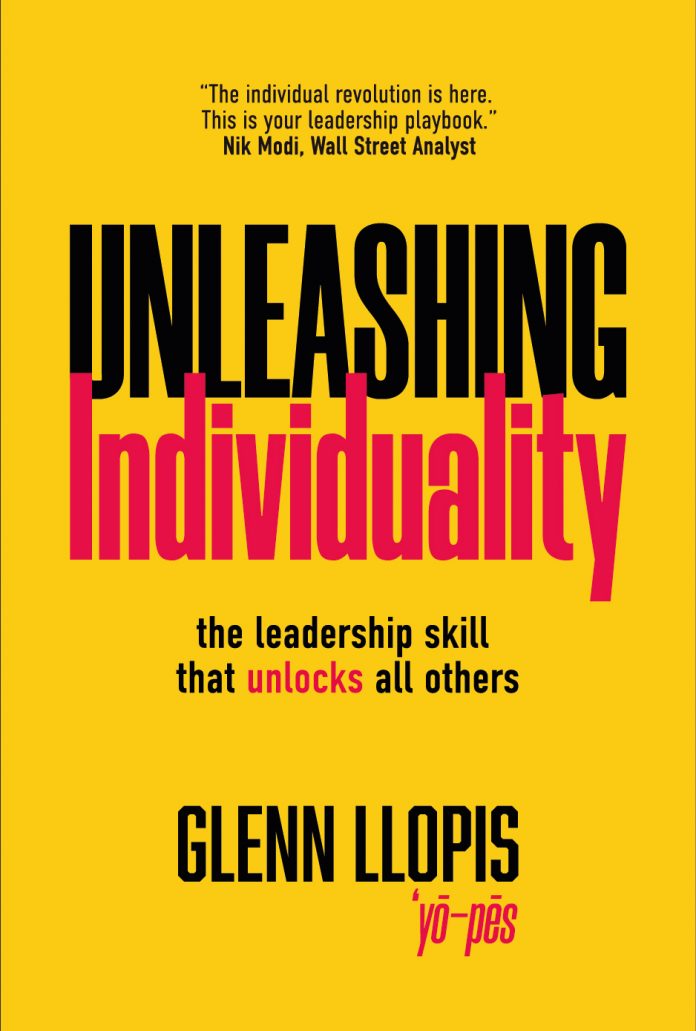
Book excerpt from Unleashing Individuality by Glenn Llopis, GLLG Press (2022)
Today’s leaders are pulled in many directions. There’s overwhelming pressure to figure out hybrid remote teams and how to thrive in our perpetual state of uncertainty. Meanwhile, leaders are trying to fulfill their promises of inclusion while elevating their commitment to personalizing wellbeing.
It can be overwhelming to decide how to develop the skills to help leaders tackle those challenges. There are plenty of step-by-step guides for using technology with remote teams, what trends to watch to survive uncertainty, how to find more diverse candidate pools, or what wellness benefits are most in demand. But those issues—while important—are secondary to our much more profound challenges stemming from our decades of suppressing individuality.
And people are DONE being suppressed:
- The No. 1 environmental, social, and governance (ESG) issue for Americans isn’t climate change: it’s the treatment of workers.
- First on HBR’s list of trends for 2022 is an emphasis on fairness and equity.
This next trend gives us a starting point:
- Helping people feel worthy is a skill that leaders need to develop: according to Deloitte’s Amelia Dunlop, it matters to nine out of 10 people to feel respected, but five out of 10 struggle to feel worthy, particularly at work.
How do we develop the skill of helping people feel worthy? It helps to get clear on what the opposite looks like and then create a process for interrupting those habits and creating new ones:
- Identify why it’s so easy to make people feel unworthy
- Show what it looks like when we’re making people think unworthy
- Extract concrete actions we can take to interrupt ourselves
Let’s get started.
1. Why it’s so easy to make people feel unworthy.
We consistently make assumptions about who belongs, where doing what, and how. And we limit and suppress people based on those assumptions.
- We make assumptions about someone’s capabilities based on what we know about their education or work experience. “You’re not qualified for this task.”
- We make assumptions about someone’s personality based on what groups we (often unconsciously) associate them with. “You’re not right for this team.”
- We make assumptions about how someone should perform a task based on how we’ve done it or seen it done in the past. “You’re doing it wrong.”
To make people feel worthy, we must train ourselves to root out assumptions that cause us to judge someone without even knowing them.
2. What it looks like when we’re making people feel unworthy.
Here’s a true story. Jeff Blue was in law school when he learned that some people get paid to listen to music for a living as A&R reps (they’re the people who see bands, scout and nurture musical talent, and bring those musicians into a record label).
“I knew intrinsically I had the qualities to be an A&R person, but I didn’t have them on paper,” said Blue. “I didn’t have the connections. I didn’t have the experience. But I knew that I had the talent and the drive.”
Blue learned that one path to becoming an A&R rep is to start by becoming someone’s assistant. He became an intern at MCA records and asked every single executive there if he could be their assistant. Every single one said no. Why? Because he was in law school.
“You’re in law school; you can’t do anything creative.”
“One person told me to take law school off my résumé.”
“You’re the type of person who would take my job.”
Those who had the power didn’t want to let him in. They saw him a certain way (not creative, out to get their jobs) because they only saw him as part of a group (lawyers), and they had strong opinions about who members of that group could be and what they could do. Ultimately, he found a different way, fighting assumptions on several fronts. Today, he is a multi-platinum A&R executive and manager whose acts have collectively sold more than 100 million albums.
3. Concrete actions we can take to interrupt ourselves.
Blue’s story reminds us: we often lack the skill of seeing people for all they’re worth. His story also gives us five places we can take action to make others feel worthy.
This is a teachable process for deliberately rooting out the assumptions that limit our views of an individual’s worth. Train leaders to question themselves as individuals, teams, and organizations – using these as starting points.
- Who you let in –
- Who makes our work impact?
- Whose perspective is missing from our planning or decision-making?
- Who can tell us who else is missing?
- How you see them –
- What assumptions are we making about people based on their roles, experience, or background?
- Whose opinions or ideas do we routinely ignore? Why?
- What happens when someone within one of our groups challenges that group dynamic? How do we react?
- Who you let them be –
- Are there strict paths for people to follow, or can individuals influence their direction?
- Are individuals free to step outside their roles?
- Do we pressure people to conform to an identity we care about rather than helping them discover their own identity?
2. What you let them do –
- Are there opportunities for people to have and share ideas even when their statements involve a function or business unit they are not part of or credentialed for?
- Are individuals encouraged to identify their capabilities and then look for opportunities to put them to use anywhere in the organization?
- Would they encounter roadblocks?
3. How you let them do it –
- Can people risk doing things in new ways?
- Or will they suffer consequences if they fail or step on toes?
- Am I open to having my own goals questioned by someone I lead?
We can learn and teach the skill of making sure people feel worthy. It’s worth it.



